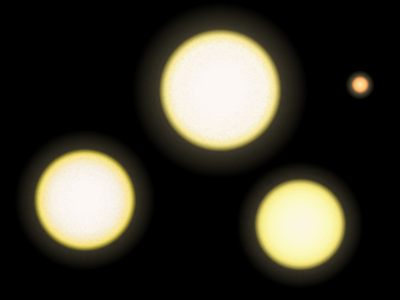What would happen if the Sun were to become as dim as Proxima Centauri?
Monday, July 14, 2008
Sometimes the most interesting parts of Wikipedia are to be found in the talk pages. The discussions there are far beyond those you generally find on forums as Wikipedia talk pages are for talking about the articles only, which means almost no useless chatter as is often the case with online forums. I just happened across an interesting discussion of what things would be like if the Sun were a red dwarf star like Proxima Centauri:
If the Sun were to become as dim as Proxima
The sun would be around -15 to - 16 m. A kind of twillight, though remarkable brighter than the full moon with about -12 m. I consider about the fact, if colour would be discernable. What colour would be faint or not visible in the light of a red dwarf? --FrancescoA (talk) 11:13, 3 April 2008 (UTC)
- It depends on what you mean by "dim". If the temperature didn't change, the colors would just be fainter (becoming gray because of poor color sensitivity of the human eye in low light). A hypothetical planet in orbit around Proxima Centauri, by contrast, should receive less energy at the shorter wavelengths. I.e. less blue. See stellar classification and black body.—RJH (talk) 16:48, 3 April 2008 (UTC)
- Thank you. Yes I also thought that the colors "grey out" in a way. Hm, would be very cold on that hypothetical earth-sun distant planet orbiting Proxima. -200°C(??), faint red twillight-light. Would be a scary stuff for a story. :) --FrancescoA (talk) 21:28, 3 April 2008 (UTC)
- Well the habitable zone would be much closer to the star, so on average an Earth-like world could be just as warm. But at that distance the rotation would be tidally locked; one side would bake and the other freeze. Any hypothetical "proximans" would probably think that no life could possibly exist around a hot, short-lived star like the Sun. ;-) I'll bet they would also be adapted to see in the infrared, so it would all look quite normal to them. —RJH (talk) 21:38, 3 April 2008 (UTC)
- Hello again. I forgot the tidal lock. Of cource, the proxima people or beings would have special developed eyes. :) --FrancescoA (talk) 21:57, 3 April 2008 (UTC)
Given the Sun's absolute magnitude of 4.83 and Proxima's 15.49, there is a difference of 10.66 which would apply to the magnitudes of all Solar System objects in orbit. Venus at greatest brilliancy is magnitude -4.5 to -4.7; apply the difference of approximately 10.7 and we see that Venus under a Proxima-like Sun wouldn't be brighter than 6th magnitude. Jupiter and Mars at their brightest would be roughly 8th magnitude, and Mars at times would dim almost to 13th. Mercury at best would be near 9th magnitude. Saturn would be around 11th or 12th magnitude most of the time, brightening to 10.3 at its most favorable oppositions. The Moon's illuminated surface would appear to be in total eclipse, dim and just discernibly red, and only the sharpest human eye would ever detect shadows under its light. -- Tony (talk) 03:14, 23 April 2008 (UTC)
- Thanks, The full moon would be IIRC -12.7m + 10.66 ~ -2m. Some people mean, Venus could cast a shadow under good circumstances. But when the full moon would be even almost 10 times "darker" then Venus, I doubt, that it could throw a shadow. --FrancescoA (talk) 08:30, 23 April 2008 (UTC)
- To be habitable by life as we know it, the Earth would need to be much closer to Proxima Centauri. Hence the luminosity of the Moon would increase accordingly. The full moon may have a comparable apparent magnitude to our own, although the reflected spectra would appear redder; perhaps more like that during a lunar eclipse.—RJH (talk) 14:49, 23 April 2008 (UTC)







0 comments:
Post a Comment